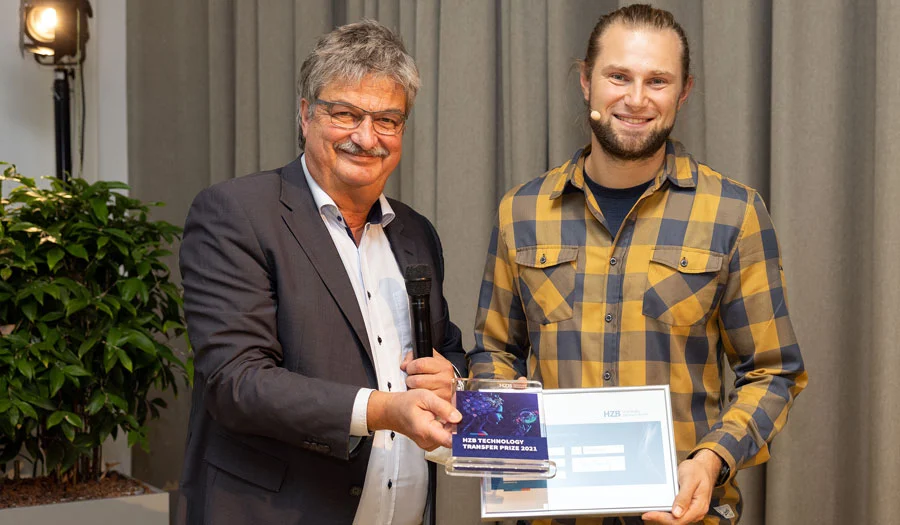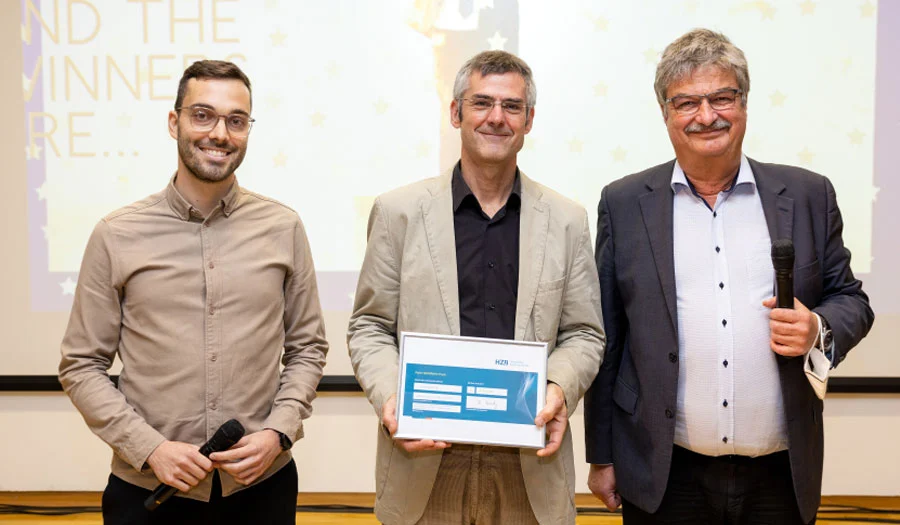Tobias Henschel wins the HZB Technology Transfer Award 2021
Digital bracelet with integrated transparent photovoltaics convinced the jury
At first glance, it looks like an ordinary wristwatch. But its glass taps the energy of the sun. A research group at Helmholtz-Zentrum Berlin has made this possible. Their transparent photovoltaics have now even made it into mass production, securing the team this year's HZB Technology Transfer Award.
Every two years, the Technology Transfer Prize, worth 5,000 euros, honors the best innovation project at Helmholtz-Zentrum Berlin (HZB). On October 5, 2021, it was that time again. Under the eyes of the audience in the BESSY II lecture hall in Berlin-Adlershof and the viewers at home in front of their screens, this year's winner was chosen. "With this award, we don't just want to honor the special achievements of HZB employees in technology transfer," says Jan Elmiger, who oversees technology transfer at HZB. "We also want to encourage all the other outstanding scientists with us to take the step from research to application with their ideas."
Eight projects
A total of eight research groups had applied for the prize. With posters, they presented their projects to the public since September 21 at the HZB sites Wannsee and Adlershof and, of course, on the Internet. These included a method for more precise quantification of the material composition in components as well as a detector for proton therapy of eye tumors, a 6-axis cryomanipulator or a spectrometer for measuring surface photovoltage. The jury, consisting of members of the industrial advisory board, selected four finalists from the pool of promising examples of successful technology transfer.
Four finalists
They presented their projects to the audience in short pitches. Daniel Amkreutz presented services for laser post-treatment and analysis of silicon-based multilayer systems, which he developed together with Martin Muske. The researchers thus offer a comprehensive toolbox for the product development of silicon-based multilayer systems.
With their LuQY Pro measurement system, Lukas Kegelmann's team helps to determine the quality of semiconductors quickly, precisely and non-invasively. This optimizes the development of optoelectronic components. In spring 2021, the scientists founded the startup Quantum Yield Berlin QYB and have already had their first commercial successes.
Christian Feiler presented innovative products for macromolecular crystallography that he developed with his team in Berlin. With his tools, he wants to support structural biologists without them having to change their usual workflow.
Tobias Henschel, on the other hand, presented transparent photovoltaics, which he developed with his team and integrated into a collection of digital wristwatches together with industrial partners.
Transparent PV wins
This ultimately convinced the jury. Maximilian Fleischer from Siemens Energy announced their decision. The industry partners agreed that the project of Tobias Hentschel and his team is a truly perfect example of technology transfer. It had been developed at the institute and successfully transferred to industry. Moreover, it had found its way into mass production. In this way, the award winners had not only generated economic success, but had also done something good for everyday life.
Peter Wohlfart-Prize for LuQY Pro
Due to a sad occasion, there was a novelty this year. Peter Wohlfart, who represented Singulus Technologies for many years at the Industry Council, passed away just a few weeks before the award ceremony. In his memory, the company together with HZB donated the Peter Wohlfart Prize, which is endowed with 2,000 euros. This went to Lukas Kegelmann's team for LuQY Pro.
Contact:
Helmholtz-Zentrum Berlin für Materialien und Energie
Dr. Jan Elmiger
Technology Transfer and Innovation
+49 30 8062 18151
elmiger(at)helmholtz-berlin.de
www.helmholtz-berlin.de/industrie/index_en.html
Press release HZB, 7 October 2021


